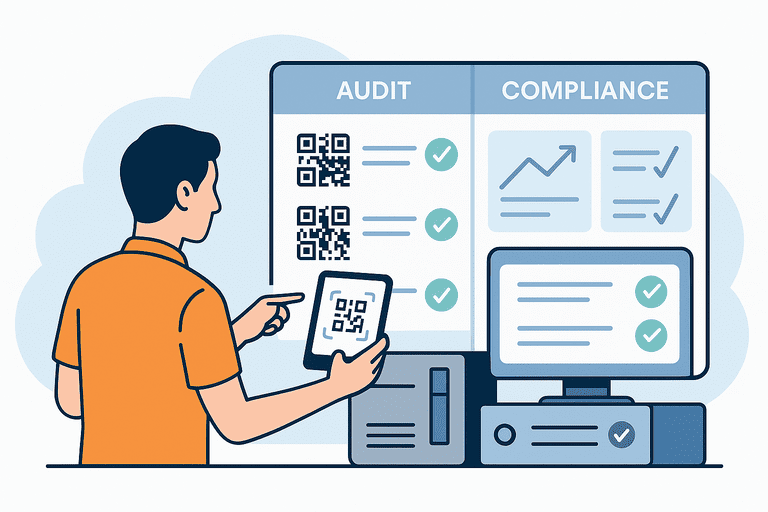Bridging Physical and Digital Audits with QR Checks
Learn how to bridge physical and digital audits using QR code checks to ensure accuracy, accountability, and compliance in asset verification.

Introduction
Traditional audits often rely on printed checklists, manual counts, and spreadsheets.
While they serve the purpose, they lack speed, traceability, and real-time insight.
On the other hand, digital audits — powered by QR code checks — connect the physical and virtual worlds, ensuring that every asset verification step is accurate, timestamped, and securely logged.
In this article, we’ll explore how hybrid audits combine the reliability of physical verification with the efficiency of digital tools.
1. The Problem with Manual Audits
Manual audit methods may seem simple but introduce major risks:
- Human error in data entry or missed items
- Duplicate or outdated records in spreadsheets
- Lack of real-time visibility for managers or compliance teams
- Delayed reconciliation between physical and system data
As businesses grow, manual methods can’t scale. Teams need an integrated system that mirrors physical audits with digital confirmations.
2. What Are QR Checks?
QR checks are asset verification actions where each item is scanned via its unique QR tag during a physical inspection or audit.
Each scan records:
- Timestamp
- User ID or auditor name
- Asset condition
- Location (optional, via GPS or workstation ID)
This creates an automated digital trail that aligns with compliance and audit requirements.
3. Bridging the Gap Between Physical and Digital
Hybrid audits combine physical verification (people scanning real items) with digital record-keeping (data stored in a central system).
This approach enables a seamless feedback loop:
| Step | Physical Layer | Digital Layer |
|---|---|---|
| Identification | Scanning QR on physical item | Pulls existing asset record |
| Verification | Confirming condition and details | Updates audit logs in system |
| Exception Handling | Reporting missing or damaged items | Auto-flags discrepancies |
| Reconciliation | Cross-check with system data | Generates audit report |
This structure ensures nothing is overlooked and every action is traceable.
4. Benefits of QR-Based Audit Systems
- Instant Data Capture — Every scan updates your audit records immediately.
- Error Reduction — No more manual entries or missed assets.
- Audit Readiness — Reports are automatically generated and exportable.
- Accountability — Each scan is tied to a specific auditor and timestamp.
- Scalability — Works across departments, locations, or warehouses.
- Condition Insights — Add photos or notes during scans for more context.
A QR system doesn’t replace physical verification — it enhances it.
5. Key Components of a QR Audit Workflow
A. Preparation
- Define which assets are in scope
- Ensure each asset has a durable QR tag
- Sync the latest asset database
B. Audit Execution
- Auditors scan items using a mobile app or handheld device
- Select asset condition or location
- Submit notes or attach images
C. Data Reconciliation
- The system automatically compares scanned data vs expected records
- Missing or duplicate entries trigger alerts
D. Review and Reporting
- Supervisors review exceptions
- Export audit summary (PDF or CSV)
- Schedule the next audit based on risk level
6. Best Practices for QR Audit Implementation
✅ Use Unique IDs
Each tag should be unique — no duplicates or reused QR codes.
✅ Tag Placement Matters
Ensure tags are visible but protected from wear (especially for tools and electronics).
✅ Train Staff Thoroughly
Even the best system fails if staff skip scans or use shortcuts.
✅ Establish Audit Frequency
Quarterly or semi-annual scans are typical for most businesses.
✅ Integrate with Asset Management
Sync audit data directly with your main asset database to avoid silos.
7. Compliance and Data Integrity
Digital audits strengthen compliance by creating verifiable trails.
Each record can be tied to:
- User activity (who scanned it)
- Timestamp
- Geolocation (if applicable)
- Condition and comments
This satisfies internal policies and external audit requirements such as ISO 9001, ISO 27001, or financial compliance frameworks.
8. The Future of Auditing
Modern audit systems are evolving to integrate:
- IoT sensors for real-time presence verification
- AI-powered anomaly detection
- Predictive audit scheduling based on asset usage
However, even with these innovations, QR scans remain the foundation — the simple yet powerful link between the physical world and digital data integrity.
Conclusion
Bridging physical and digital audits with QR checks offers a balanced, transparent, and scalable method of asset verification.
It enhances trust, saves time, and strengthens compliance by connecting what’s on the ground with what’s in your system — one scan at a time.
Explore related compliance and audit insights: